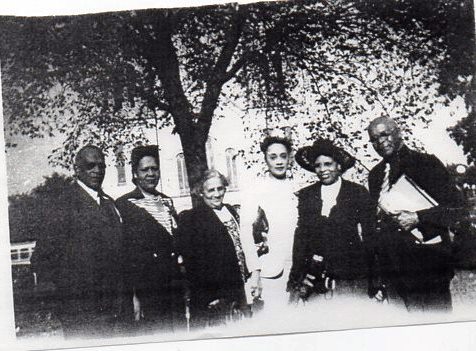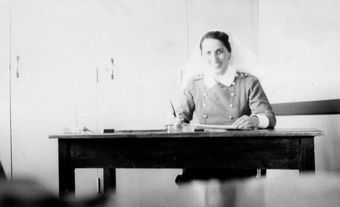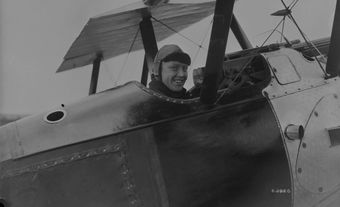John Christie Holland, pastor, community leader, activist and railway Pullman attendant (born 25 December 1882 in Hamilton, ON; died 22 June 1954 in Hamilton). Holland was the first Black person to be honoured as Distinguished Citizen of the Year in a major Canadian city.
Family Background and the Underground Railway
Family stories trace John Christie Holland's ancestry back to the west coast of Africa in 1792. They tell of Dutch slave traders raiding the Village of the Tall Men and kidnapping John’s great-grandfather into enslavement. He and the hundreds of other captives were confined to the hold of a ship and transported to the United States. There he was given the name William and sold as a slave to a plantation owner in Maryland. William and his wife Chloe had several children, including son William Augustus Holland (usually referred to as Augustus or Gustus).
Augustus was later sold to the Howard plantation in Sandy Spring, Maryland. He married Leatha, and the couple had three daughters and two sons, William and Thomas (John’s father). They were likely given the last name Howard after the plantation owner, a common practice.
William, the eldest son, escaped to Canada when he was 18 or 19. It was not long before Thomas joined him. Thomas was only 15 years old in 1860 when he escaped through the Underground Railroad to Canada; according to family stories, Thomas crossed the Niagara River into the country. He eventually settled in Hamilton, Ontario. Both he and William adopted “Holland” as their last name in honour of their father and to elude bounty hunters from the United States (see Fugitive Slave Act of 1850).
After a few years of farming, Thomas established a small but flourishing flour and feed store in Hamilton. Like most fugitive slaves, he was very spiritual and regularly attended church in Hamilton. He also visited a small mission on the escarpment above Hamilton, where he met Henrietta Shortts (they married in 1875). Unlike Thomas, she had been born free in Hamilton. While Thomas was illiterate, Henrietta could read and write. She insisted that if they had children, they would be educated, so the couple bought a house in the city, within walking distance to schools.
Early Life and Influences
Henrietta gave birth to 13 children — 9 survived to adulthood (4 died as very young children, one from whooping cough, one from tuberculosis, one from diarrhea and one of severe burns following a tragic accident). Their fifth child arrived on Christmas Day, 1882, and was appropriately named John Christie (for Christmas) Holland.
The Hollands were deeply involved in the local church. Thomas was superintendent of St. Paul’s African Methodist Episcopal Church in Hamilton, the only church serving the city’s Black community. Thomas served as choirmaster and his booming bass voice was the foundation of the church choir. Henrietta was also an officer of the church and the entire family attended church service and Sunday school.
John Holland learned the value of hard work from his parents. His father, Thomas, ran the store and travelled around Canada and the United States as a member of the famous O’Bannyan Jubilee Singers (later known as the Canadian Jubilee Singers). To augment the family income, his mother, Henrietta, sold straw for stuffing mattresses along with homemade jams and preserves at the local farmers’ market. The monies earned were invested in music lessons and schooling for their children.
The boys helped in the store and found part-time jobs after school. John got a job selling the Hamilton Spectator newspaper when he was 11. While selling papers he was sometimes taunted by bullies hurling racial insults.
He studied hard at Hamilton’s Central Collegiate high school, hoping to study theology and become a preacher. Although a teacher, Miss Burrow, told Thomas and Henrietta of John's intellectual abilities, there was no money to finance a university education.
Education and Work
With no money for college, Holland looked for work. Job choices in the early 1900s were limited for a Black man, so he began a series of jobs, first working as an orderly and masseur at Miss Brown’s private hospital in Oakville. There he met Josephine Idenia Johnson, whom he would marry in 1901. (They would have five children: Gilbert, Gladys, Thomas, Alfreda and Oliver — sadly, Thomas died at only four months of age.)
Holland later found a day job as a labourer at a local tannery and continued working evenings and weekends at the hospital. In addition to repeated derogatory racial comments by his Caucasian co-workers, Holland was discouraged by his employer’s unwillingness to promote him because of his race; however, the work was both necessary and the means to further education. In 1912, he was hired as a janitor at the Westinghouse plant in Hamilton. While he worked, Holland bought books and began studying for the ministry, taking correspondence courses through Wilberforce College, based in Ohio.
In 1916, Holland began working as a porter at the Hamilton station of the Toronto, Hamilton and Buffalo (TH&B) Railway. He was soon promoted to Pullman attendant, an onboard position serving primarily passengers in sleeping cars. This meant he was away from home for days at a time. He was soon assigned to the “Hamilton” car, the private or business car used by railway president H. T. Malcolmson, as well as top officials of affiliated rail lines and prominent Hamilton businessmen. His professionalism, discretion and wisdom earned him the respect and admiration of many of those in positions of influence, while his selflessness made him a favourite of passengers and co-workers. These relationships served him well in his community work, where he earned high regard from Blacks and Caucasians alike.
Pastor
While Holland worked on the railroad, he continued to study for the ministry through Wilberforce College. He also volunteered so often at St. Paul’s African Methodist Episcopal (AME) Church that the pastor, Reverend Claude Stewart, viewed him as an assistant. At 42 years of age, Holland completed his studies and became an ordained minister of the AME Church. However, he continued working with the railway.
Before Pastor Stewart died in 1937, he insisted Holland be his successor. The TH&B railway continued to employ Holland as a porter, but gave him every Sunday off so that he could maintain a source of income (his pastoral charge was unpaid). Holland gained prominence as a preacher in Hamilton and was often requested as a guest speaker. He also performed with his church choir (along with his son Oliver), which frequently appeared at functions across the city.
When Holland accepted the position of pastor of St. Paul’s, the economy was still reeling from the Great Depression. Discriminatory hiring practices meant that Blacks were much harder hit by job losses, poverty and homelessness. As the congregation suffered financially, offerings to the church dwindled. The church fell deeply into debt and disrepair and was slated for tax sale. Holland sought help from then-mayor William Morrison at City Hall and the city commissioner of finance, Eric R. C. Bower. As a result, a tag day was held (tag days were fundraisers during which donors received a tag indicating their support). This tag day raised enough money to pay the tax arrears and outstanding mortgage interest, with some money left over to begin repairs. Subsequently, a trust fund committee (including several influential Hamiltonians) was put in place to oversee the church’s financial affairs. In order to retain the support of the many Caucasian people who had helped save the church from foreclosure, the church severed ties with the African Methodist Episcopal denomination. The church became non-denominational and in 1937 was renamed Stewart Memorial Church in honour of Holland’s predecessor, Reverend Stewart.
Community Activist
Holland dedicated himself completely to his church, his congregation and his community. Wilma Morrison, a church member, knew the reverend well and told how in the early 1940s, Holland learned that a restaurant in the city was snubbing Black customers; on several occasions, he gave Morrison and a few friends 25 cents each to go and “sit-in” until they were served. Morrison also recalls a time she and two other Black women went to the city’s employment service office to secure work. They arrived shortly after the office opened, dressed in business attire, and filled out necessary forms. Despite reminding staff of their presence, they were passed over for over three hours while Caucasian applicants were summoned and sent on job interviews. The women sought help from Reverend Holland, who immediately spoke to the person in charge and within minutes had work papers for all three women.
Holland also volunteered as a liaison between the Canadian Immigration Department and National Employment Service to help resolve misunderstandings arising from racial differences between employer and employee. In addition, he worked with McMaster University to find affordable lodging for international students who were having difficulty finding accommodation due to racial discrimination.
Citizen of the Year
In 1953, Holland was named Hamilton’s Distinguished Citizen of the Year, the first Black person in Canada to receive such an honour. Accolades and congratulations came in from all over the world from the many people he had served through the church and in his duties on the railroad. Feeling humbled by the honour, he worked himself to exhaustion, believing he must live up to this distinction.
Despite health concerns, Holland continued his philanthropic work. In March 1954, while visiting colleagues in Boston, Holland suffered a brain hemorrhage. He died on 22 June and was buried at Woodland Cemetery in Hamilton. He was survived by his second wife, Rachel Allen (a close friend of Josephine, who had passed away 18 December 1944). Sadly, Holland was also predeceased by daughters Gladys, who died of tuberculosis at the Mountain Sanatorium in 1925, and Elfreda (or Freda), who died in 1932 following surgery to remove nasal polyps.
Family Achievements
Holland was not the only member of the family with talent and determination.
Music and literature were staples in Holland’s childhood home, and several of his siblings were quite accomplished. Grace, the youngest, was an elocutionist and storyteller. Holland’s eldest brother, William, studied voice and was a member of the Canadian Jubilee Singers. He later moved to New York City and performed on Broadway. Their sister, Kathleen, was an Associate of the American Guild of Organists (AAGO) and one of the pre-eminent pipe organists in North America, accompanying renowned singers such as Roland Hayes. The distinguished African-American congressman and Minister Adam Clayton Powell invited her to play in his famed Abyssinian Baptist Church in Harlem. Kathleen also gave recitals in Canada, the United States and the Caribbean.
Holland’s children were talented as well. He and his wife Josephine made education and the study of music high priorities for their children and worked tirelessly to provide opportunities for them. One son, Gilbert, was a gifted singer who, like his uncle William, moved to New York; he also performed internationally. In addition, Gilbert was an accomplished athlete in both track and field (hurdles) and boxing and reportedly competed in the 1924 Paris Olympic Games.
Gladys and Alfreda studied both piano and organ at the Hamilton Conservatory of Music, and Oliver studied voice. In 1936, Oliver graduated from McMaster University, and he went on to study law at Osgoode Hall in Toronto, one of the school’s first Black Canadian graduates. In the 1940s, he opened his own law practice, the first Black Canadian to do so in Hamilton.
Legacy
The first Black person to be named Distinguished Citizen of the Year by a Canadian city, Holland is also credited with saving Stewart Memorial Church (formerly St. Paul’s African Methodist Episcopal Church) from physical and financial ruin. The church itself is historically significant. Until it was officially integrated and renamed in 1937, St. Paul’s African Methodist Episcopal Church was the only church in the city for Black Hamiltonians. It was designated an Ontario Heritage Site because of its significant link to fugitive slaves and the Underground Railroad.
In 1996, Hamilton established the John C. Holland Awards as part of the city’s sesquicentennial commemorations. At a dinner held every February (during Black History Month), the city celebrates his life by focusing on diversity and recognizing distinguished community members for their outstanding contribution, professional accomplishments or academic achievement.
In 2003, Holland was inducted into Hamilton’s Gallery of Distinction.

 Share on Facebook
Share on Facebook Share on X
Share on X Share by Email
Share by Email Share on Google Classroom
Share on Google Classroom




